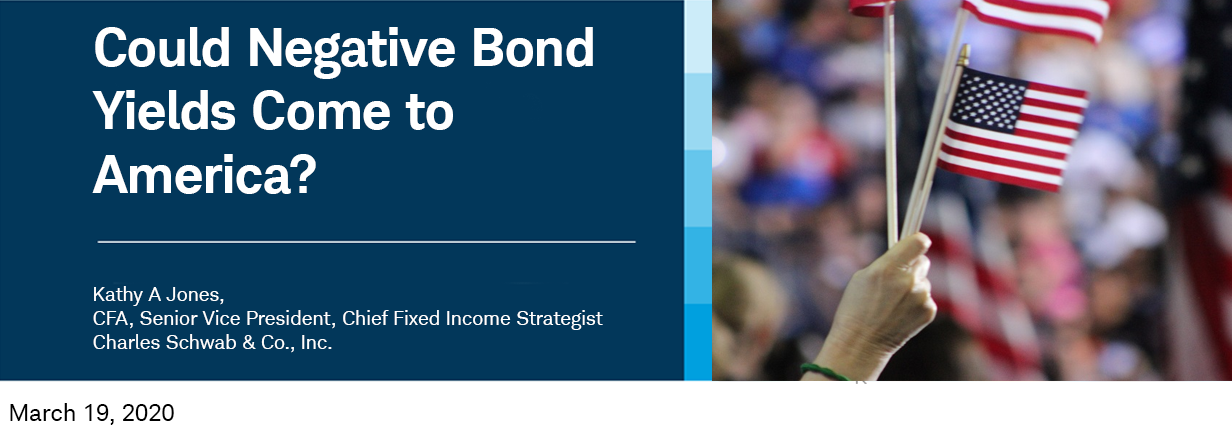
View recent market volatility updates from Schwab
The answer is no … and yes. Although you can never say never when it comes to markets, we believe that the Federal Reserve is not in favor of setting the federal funds rate at a negative yield. However, it is possible that Treasury yields could fall below zero in the event of a steep or prolonged downturn or recession.
The Fed likely will resist a negative “policy rate”
Some background: A policy rate is what a central bank uses to implement or signal its monetary policy stance—it can cut the rate to stimulate borrowing and economic activity, or raise the rate to make borrowing more expensive and cool off the economy. The specific rate varies by country. In the United States, it’s the federal funds rate, which is the interest rate banks charge each other for overnight loans.
As central banks around the world have struggled to revive inflation and support economic growth, the policy rates set by the Bank of Japan and the European Central Bank (ECB) have been at or below zero for quite some time.
Meanwhile, intermediate- and long-term bond yields have also fallen into negative territory. There are currently more than $10 trillion in negative-yielding bonds around the world.
There is about $10 trillion in negative-yielding bonds in the global market

Source: Bloomberg Barclays Global Aggregate Negative Yielding Debt Market Value USD. Monthly data as of 03/17/2020.
However, there doesn’t appear to be much support among members of the Federal Reserve for a negative policy rate. After the Fed’s emergency rate cut on March 15th, Fed Chair Jerome Powell indicated that the Fed didn’t see negative rates as “an appropriate policy tool.”
However, markets could drive Treasury yields into negative territory
Treasury securities are auctioned on a regular basis and traded actively. If the demand for those securities is very strong, prices will rise, and yields—which move inversely to prices—could become negative even if the federal funds rate isn’t.
Here’s how the math works: Yields for intermediate- and long-term bonds are the sum of the average of short-term yields plus a risk premium (referred to as the “term” premium). Consequently, expectations for the course of Fed policy can play a big role in determining where longer-term bond yields will go.
Over the past few years, the term premium has been negative, as investors haven’t demanded extra yield to compensate for the risk of the Fed raising short-term interest rates more than the market expects. In other words, intermediate- and long-term Treasury yields were below the level that the future path of the federal funds rate implied.
Looking at the current situation, the market expects that the Fed will keep policy on hold for the next year or two. If expectations for the Fed to start raising rates get pushed even further into the future, then yields for bonds with maturities of two years or more could fall below the federal funds rate.
It happened in Germany in 2012. Two-year note yields fell into negative territory even though the European Central Bank’s policy rate didn’t drop below zero until 2014.
German 2-year yields went negative nearly two years before the ECB policy rate dropped below zero

Source: Bloomberg. ECB Deposit Facility Announcement Rate (EUORDEPO Index), Generic Germany 2-year Government Bond (GTDEM2Y GOVT), Generic Germany 10-year Government Bond (GTDEM10Y GOVT). Monthly data as of 02/28/2020.
Past performance is no guarantee of future results.
Why would anyone buy a negative-yielding bond?
There are four main reasons that an investor might choose to buy a negative yielding bond:
- 1. Safety. Investors seeking safety in a time of disruption might choose to pay for the security of a Treasury bond. U.S. Treasury securities are considered risk-free, and when markets are in turmoil, investors may prefer to lose a small amount in exchange for knowing that the rest of their principal is safe.
- 2. Deflation fears. If an investor believes that prices will fall, then the purchasing power of the money saved, even with a negative yield, could rise.
- 3. Speculation. Some investors may believe that yields will continue to fall and therefore believe that the price of their negative-yielding bonds will rise, providing capital gains that offset the negative yield.
- 4. Regulatory requirements. Institutional investors like banks may be forced into holding Treasury securities by regulation and have to accept the cost of those negative yields to comply with requirements.
We don’t suggest that investors purchase bonds with negative yields. However, investors may end up holding them at some point if the economy continues to weaken or flight-to-safety Treasury buying intensifies.
We also counsel caution to investors who place orders for Treasury securities through the U.S. Treasury Department’s auction process. This is a Dutch auction, in which the yield on a given security is not known until the auction is over. It’s possible that the rates on Treasury bills sold at auction could be negative.
Implications for investors
We see the potential for some Treasury securities to provide negative yields. If that happens, we believe investors should consider alternatives, like bank certificates of deposit (CDs) or highly rated corporate or municipal bonds. However, keep in mind that even highly rated corporate or municipal bonds have higher risks than Treasury securities. If short-term Treasury yields do in fact dip below zero, you can explore other cash solutions that might still offer positive yields.
Also, we continue to suggest investors consider using bond ladder and/or barbell strategies to manage the duration in their portfolios.








